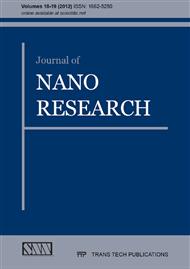[1]
P. I. Williams, D. G. Lord, P. J. Grundy, Magnetostriction in polycrystalline sputter-deposited TbDyFe films, J. Appl. Phys. 75 (1994) 5257-5261.
DOI: 10.1063/1.355724
Google Scholar
[2]
N. H. Duc, K. Mackay, J. Betz, D. Givord, Giant magnetostriction in amorphous (Tb1−xDyx)(Fe0. 45Co0. 55)y films, J Appl. Phys. 79 (1996) 973-977.
DOI: 10.1063/1.360881
Google Scholar
[3]
S. Priya, R. Islam, S. Dong, D. Viehland, Recent advancements in magnetoelectric particulate and laminate composites, J. Electroceram. 19 (2007) 147-164.
DOI: 10.1007/s10832-007-9042-5
Google Scholar
[4]
W. Eerenstein, N. D. Mathur, J. F. Scott, Multiferroic and magnetoelectric materials, Nature, 442 (2006) 759-765.
DOI: 10.1038/nature05023
Google Scholar
[5]
J. Zhai, Z. Xing, S. Dong, J. Li, D. Viehland, Magnetoelectric Laminate Composites: An Overview, J. American Cer. Soc. 91 (2008) 351-358.
DOI: 10.1111/j.1551-2916.2008.02259.x
Google Scholar
[6]
X. W. Dong, B. Wang, K. F. Wang, J. G. Wan, J. M. Liu, Ultra-sensitive detection of magnetic field and its direction using bilayer PVDF/Metglas laminate, Sensors and Actuators A, 153 (2009) 64-68.
DOI: 10.1016/j.sna.2009.04.033
Google Scholar
[7]
P. Farber, H. Kronmüller, Crystallization behaviour and magnetic properties of highly magnetostrictive Fe-Tb-Dy thin films, J. Magn. Magn. Mater. 214 (2000) 159-166.
DOI: 10.1016/s0304-8853(00)00164-5
Google Scholar
[8]
G. Ausanio, A. C. Barone, V. Iannotti, P. Scardi, M. D'Incau, S. Amoruso, M. Vitiello, L. Lanotte, Morphology, structure and magnetic properties of (Tb0. 3Dy0. 7Fe2)100-xFex nanogranular films produced by ultrashort pulsed laser deposition, Nanotechnology, 17 (2006).
DOI: 10.1088/0957-4484/17/2/033
Google Scholar
[9]
H. Uchida, Y. Matsumura, H. Uchida, H. Kaneko, Progress in thin films of giant magnetostrictive alloys, J. Magn. Magn. Mater. 239 (2002) 540-545.
DOI: 10.1016/s0304-8853(01)00659-x
Google Scholar
[10]
S. Stein, M. Wuttig, D. Viehland, E. Quandt, Magnetoelectric effect in sputtered composites, J. Appl. Phys. 97 (2005) 10Q301-03.
DOI: 10.1063/1.1846631
Google Scholar
[11]
L. R. Doolittle, Algorithms for the rapid simulation of Rutherford backscattering spectra, Nucl. Instrum. Meth. Phys. Research B, 9 (1985) 344-351.
Google Scholar
[12]
M. A. Reis, L. C. Alves, DATTPIXE, a computer package for TTPIXE data-analysis, Nucl. Instrum. Meth. Phys. Research B, 68 (1992) 300-304.
DOI: 10.1016/0168-583x(92)96098-j
Google Scholar
[13]
E. Quandt, A. Ludwig, J. Mencik, E. Nold, Giant magnetostrictive TbFe/Fe multilayers, J. Alloys and Compounds, 258 (1997) 133-37.
DOI: 10.1016/s0925-8388(97)00061-3
Google Scholar
[14]
E. Quandt, A. Ludwig, Giant magnetostrictive multilayers, J. Appl. Phys. 85 (1999) 6232-37.
Google Scholar


